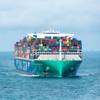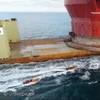With more and more ships navigating in polar waters, IMO has moved to address international concern about the protection of the polar environment and the safety of seafarers and passengers with the introduction of new regulations that all ships operating in these harsh and challenging waters must comply with.
The mandatory Polar Code, for ships operating in Arctic and Antarctic waters, enters into force on 1 January 2017, marking a historic milestone in the work of the International Maritime Organization (IMO) to address this key issue.
Its requirements, which were specifically tailored for the polar environments, go above and beyond those of existing IMO conventions such as MARPOL and SOLAS, which are applicable globally and will still apply to shipping in polar waters.
Trends and forecasts indicate that polar shipping will grow and diversify over the coming years. In the Arctic, commercial shipping can make significant reductions in voyage distances between Europe and the Far East by sailing northern routes, while both the Arctic and Antarctic are becoming increasingly popular tourist destinations.
These challenges need to be met without compromising either safety of life at sea or the sustainability of the polar environments.
Ships operating in the polar regions face a number of unique risks. Poor weather conditions and the relative lack of good charts, communication systems and other navigational aids pose challenges for mariners. And if accidents do occur, the remoteness of the areas makes rescue or clean-up operations difficult and costly.
Extreme cold may reduce the effectiveness of numerous components of the ship, including deck machinery and emergency equipment. And when ice is present, it can impose additional loads on the hull and propulsion system.
To address all these issues, the Polar Code sets out mandatory standards that cover the full range of design, construction, equipment, operational, training and environmental protection matters that apply to ships operating in the inhospitable waters surrounding the two poles.
Protective thermal clothing, ice removal equipment, enclosed lifeboats and the ability to ensure visibility in ice, freezing rain and snow conditions are among the Code’s mandatory safety requirements.
The regulations extend to the materials used to build ships intended for polar operation, and all tankers under the Code will have to have double hulls. From an environmental perspective, the code prohibits or strictly limits discharges of oil, chemicals, sewage, garbage, food wastes and many other substances.
The Polar Code will make operating in these waters safer, helping to protect the lives of crews and passengers. It will also provide a strong regime to minimise the impact of shipping operations on the pristine polar regions.
It will be seen as a major achievement in IMO’s work to promote safe and sustainable shipping in all regions of the world, including the most challenging and difficult.













